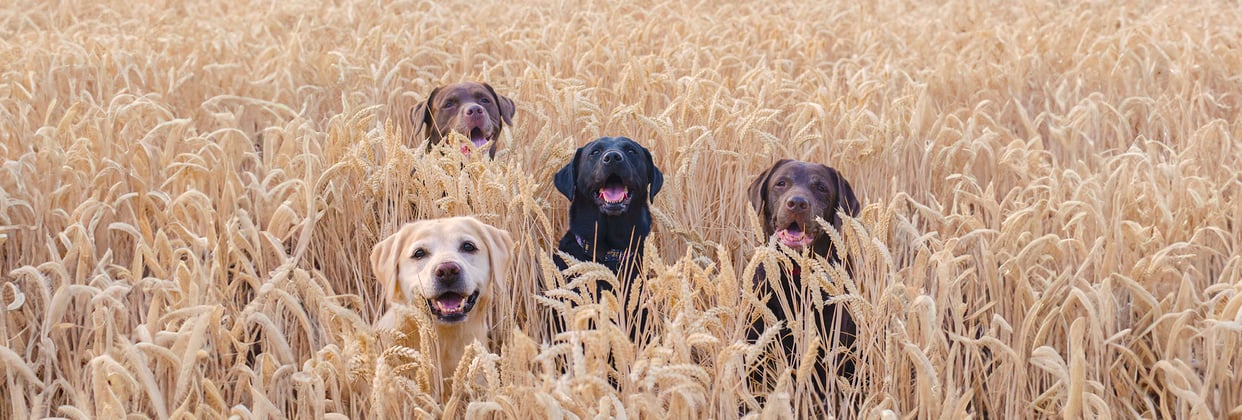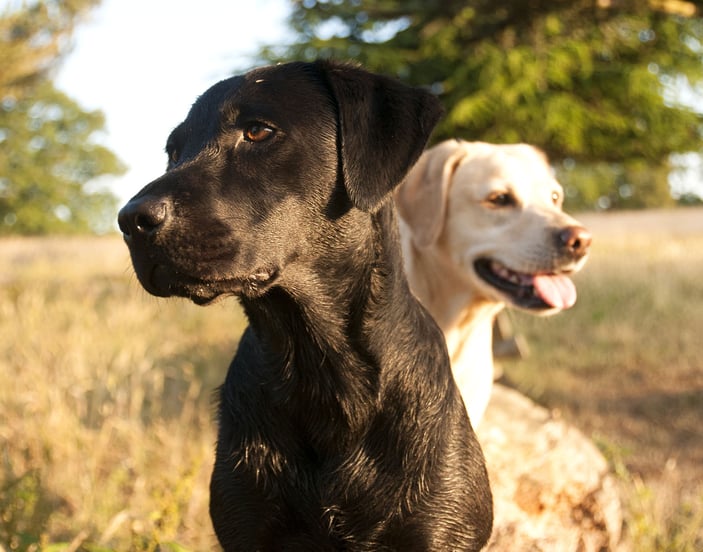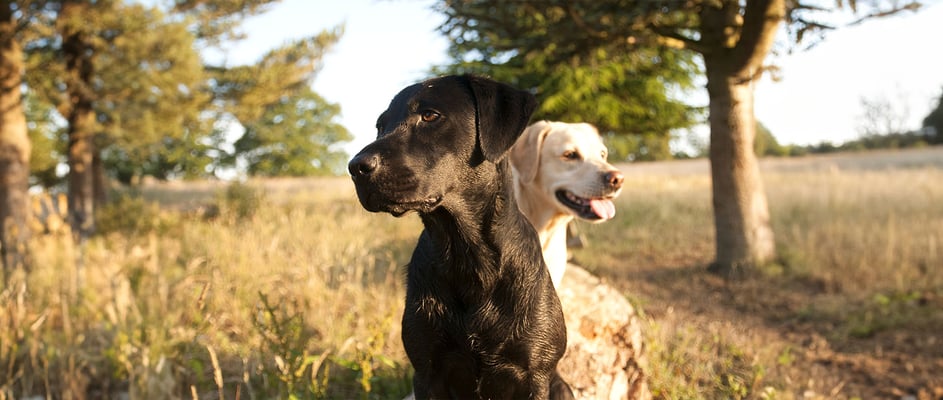The guide to owning a Labrador.
Want to know everything there is to know about finding the right dog for you? Submit your email below, and we’ll send you a one-stop guide to help you on your pet-ownership journey.
Jump to:
Stats at a glance
A history of Labradors
Labradors, also known as Labrador Retrievers, originated in the Canadian island of Newfoundland during the 18th century. They were initially bred by fishermen to help retrieve full fishing nets from the icy waters of the North Atlantic. These early dogs were likely a mix of local breeds and water dogs.
In the 19th century, Labradors were further developed in England, where they were refined for their retrieving abilities, intelligence, and friendly temperament. They were favoured by English nobility for hunting purposes, particularly for retrieving game during hunting expeditions.


By the early 20th century, Labradors had gained popularity not only in England but also in North America. They were recognised by kennel clubs and became established as a distinct breed. Over time, Labradors diversified into two main types: the American Labrador and the English Labrador, which have subtle differences in appearance and temperament.
Today, Labradors are one of the most popular and beloved dog breeds worldwide. They are known for their friendly and outgoing nature, intelligence, and versatility in various roles, including as family pets, working dogs, and service animals. They excel in activities like retrieving, hunting, search and rescue, and as assistance dogs for people with disabilities.
How much is a Labrador Retriever puppy (UK)?
Labrador puppies in the UK typically range from around £800 to £2,000. However, it’s important to note that these prices are an estimate and can vary according to factors such as the dog's pedigree, the reputation of the breeder, and the specific region of the UK where you purchase your pup. At Waggel, we always recommend choosing a responsible and reputable breeder who prioritises the health and well-being of their dogs.
Colours and coat types
Labrador colours
Labrador Retrievers are known for their diverse coat colours, which primarily come in three variations: black, yellow, and chocolate.
Black Labradors are the most common among the breed. They have a solid black coat that extends from their nose to their tail, with no other colour variations. This classic black colouring is a hallmark of the breed.
Yellow Labradors exhibit a wide range of shades, from a very light cream or nearly white colour to a deeper, fox-red hue. Their noses and eyes are typically brown. Interestingly, even within the same litter, yellow Labs can display variations in shade, showcasing the breed's natural diversity.
Chocolate Labradors boast a rich, brown coat that spans a spectrum from a light, almost latte shade to a deep, dark chocolate hue. Like their yellow counterparts, they have brown noses and eyes. This distinctive colouring sets them apart in the Labrador family.





Labrador coats
In addition to the variation in coat colour, Labrador Retrievers also have two primary types of coats; single and double.
Labradors with a single coat possess a dense, water-resistant outer layer along with a soft, insulating undercoat. The outer coat is relatively short, straight, and dense, providing protection from the elements.
However, most Labradors in the UK have a double coat which includes the same dense outer layer and a thicker undercoat. This double coat offers extra insulation and protection, particularly in harsh weather conditions.
Regardless of coat type or colour, Labrador Retrievers are known for their low-maintenance coats. While regular grooming is essential to keep their coats healthy and manage shedding, Labrador fur is generally straightforward to care for. Routine brushing and occasional baths are typically all that's needed to maintain their coat in excellent condition!
Size and weight
Labradors are considered a medium to large dog breed and are expected to grow in height to around 55 to 62 inches tall. Weight-wise, they tend to come in at around 25 to 36 kg depending on their sex and age.
Keep in mind that individual Labradors may fall outside these averages. Some may be slightly smaller or larger depending on various factors including genetics, diet, and exercise.
Temperament
Labradors are widely known for their suitability as pets due to their friendly and adaptable nature. They are beloved companions in a variety of households, thanks to their excellent temperament and ability to interact with humans. These dogs thrive on social bonds and typically respond well to training, making them wonderful additions to families and individuals alike.
Labradors make excellent family dogs due to their affectionate, patient, and good-natured disposition. Their tolerance and willingness to engage in family activities mean they often become cherished members of the household. They adapt well to the hustle and bustle of family life and are known for their loyalty.


When it comes to children, Labrador Retrievers are generally considered the very best of companions. Their gentle and patient nature aligns well with the energy and curiosity of young kids. Nevertheless, like any dog breed, it's vital to educate both children and dogs on safe and respectful interactions to ensure a harmonious coexistence.
Labradors can often coexist peacefully with cats and other pets, provided they are introduced to them at a young age and undergo proper socialisation. Their sociable disposition means they can adapt to living with a variety of animals, including dogs of different breeds.
Behaviour
Labradors can be prone to experiencing separation anxiety, especially if they’re not accustomed to being alone for long periods. They are known for their sociable and people-oriented nature and thrive on human companionship. When left alone for extended periods without proper training and gradual acclimation, Labradors may exhibit signs of distress, such as excessive barking, destructive behaviour, or soiling in the home.
While Labradors are generally sociable dogs, with proper training and gradual adjustment, they can learn to be comfortable being alone for moderate durations. It's essential to start training them for alone time from a young age, gradually increasing the duration as they become more accustomed to it. Providing mental stimulation, toys, and a comfortable environment can help alleviate potential anxiety.
Labrador Retrievers can adapt to apartment living, but it's important to note that they are active dogs that require regular exercise and mental stimulation. Apartment living can work well for Labradors as long as their exercise needs are met through daily walks, playtime, and potentially trips to a nearby park. This situation is probably more suited for somebody who works remotely at home and can take regular breaks with their dog.
It’s also important to note that Labradors can be quite moderate barkers, however, this isn’t a bad thing! They usually bark to alert their owners of something unusual, but they are not typically considered excessive barkers compared to some other breeds.
Check out our guide about their effectiveness as guard dogs in our post are Labradors good guard dogs?


Training a Labrador Retriever
The good news is that Labrador Retrievers are known for their smarts! They often catch on quickly to what you're teaching them, which makes training sessions fun and rewarding. With a bit of patience and consistency, you'll be amazed at how fast they pick up on things.
When it comes to toilet training, Labs are generally cooperative. They're quick learners and want to please their owners, which makes the process a bit easier. With a regular schedule and positive reinforcement, they usually get the hang of it in a relatively short time. Of course, accidents might happen, but that's all part of the learning process for a young pup and requires lots of patience from you.
Labs tend to be quite obedient, especially if they're well-trained from a young age. They're naturally eager to follow commands and aim to make their owners happy. However, it's important to remember that every dog is unique, and some Labs may have a more independent streak. With consistent training and positive reinforcement, though, you'll find that Labradors are generally very obedient and make wonderful, well-behaved companions.
Shedding and grooming
How often should I brush my Labrador?
Brushing your Labrador Retriever's coat is important to keep it healthy and shiny. Aim to brush them at least two to three times a week, or even more frequently during shedding seasons. This helps remove loose fur and prevents tangles, especially in their dense double coat. It's also a great bonding activity between you and your furry friend and also stops a build-up of tumbleweeds around your home.
How often should I bathe my Labrador?
Bathing a Labrador should be done on an as-needed basis. They have a water-resistant coat, so they don't need frequent baths. Too much bathing can strip their skin of natural oils and lead to skin issues. Generally, a bath every two to three months or when they get particularly dirty is sufficient. Remember to use a dog-specific shampoo that's gentle on their skin or take them for a pamper from a local dog groomer.
How often should I cut my Labrador’s hair?
Unlike some other breeds, Labradors do not require regular haircuts. Their coat naturally regulates itself and doesn't grow excessively long. However, if you notice their fur is getting too long or tangled, it's best to consult a professional groomer for trimming. Overly frequent cutting may damage their coat, so it's usually not necessary unless there's a specific issue.


Do Labradors shed?
Labrador Retrievers are known for shedding quite a bit, especially during seasonal changes so you might want to stock up on a lint roller or pet-specific vacuum. Expect heavier shedding in the spring and autumn months. Regular brushing can help to manage this but be prepared for some fur around your home. It's a normal part of having a Labrador and can be kept under control with regular grooming.
Do Labradors drool?
Labradors are generally not heavy droolers. While some individuals might drool occasionally, it's not a prominent trait of the breed.
How often should my Labrador’s nails be trimmed?
Like all dogs, they do need their nails trimmed regularly. Aim to do this about once a month, or when you hear their nails clicking on the floor. Long nails can be uncomfortable for your Lab and may lead to joint issues if not addressed. If you're not comfortable trimming their nails yourself, a professional groomer or veterinarian can help.
Exercise needs
Labrador Retrievers are an energetic breed and need a good amount of exercise to stay happy and healthy. They thrive on physical activity and generally require at least 30 to 60 minutes of moderate to vigorous exercise each day. This can include activities like brisk walks, jogging, playing fetch, or swimming, as Labs tend to love the water.
Playtime is crucial for Labradors, as they're known for their playful and sociable nature. Interactive games like fetch, tug-of-war, and puzzle toys are great ways to keep them engaged and mentally stimulated. These activities will also strengthen the bond between you and your pup. Providing them with a variety of toys to explore and chew on can help keep them mentally active and prevent boredom or destruction in your home.
Mental stimulation is just as important as physical exercise for a Labrador. Consider using treat-dispensing toys or engaging them in scent games to challenge their problem-solving skills. Puzzle toys that require them to work for treats can also provide mental stimulation.





Feeding and nutrition
The best food for a Labrador Retriever depends on factors like their age, activity level, and any specific dietary needs or sensitivities they may have. Generally, high-quality dog foods that list a protein source as the first ingredient and contain balanced nutrients are a good choice. Look for options that meet high standards such as Butternut Box; a Waggel partner. Butternut Box provides fresh and perfectly-portioned meals for dogs of all ages and breeds. Best of all, it’s made from human-quality meat and fish and is free from fillers and artificial preservatives.
For personalised feeding recommendations, it's best to consult your vet. In general, adult Labradors typically require around 2.5 to 3 cups of high-quality dog food per day, split into two meals. Puppies and more active adults may require more, while older or less active Labradors may need slightly less. Adjustments may also be needed based on factors like weight, metabolism, and any health issues.
Remember to monitor your Labrador's weight and adjust their portion sizes accordingly. Avoid overfeeding, as obesity can lead to health problems. Don’t forget to always provide fresh water and consider feeding a consistent diet to avoid stomach upset. Consulting with your vet is a proactive step in the pet ownership journey and ensures you're providing the right amount and type of food to keep your Labrador happy and healthy.
Labrador Retriever common health issues
Labradors are generally a robust and healthy breed and have a lifespan 10-12 years on average. However, like all dogs, they can be prone to certain health issues. Common concerns for Labradors include hip and elbow dysplasia, which can lead to joint problems. Labradors are also known for their love of food, so portion control is important to maintain a healthy weight. Regular veterinary check-ups and early detection of any potential health issues can help ensure a long and happy life.
To help you gain a better understanding of the conditions, treatment and insurance claim costs associated with Labradors, we’ve compiled the following list with data based on claims from 2022 to 2023:
Hip dysplasia: This is a hereditary condition where the hip joint doesn't develop properly, causing instability and leading to arthritis over time. Symptoms may include limping, difficulty in rising, and muscle atrophy in the hind legs. Treatment can range from weight management and physical therapy to surgical procedures like hip replacement, with costs in the UK averaging between £1,500 to £4,000.
Epilepsy: This neurological disorder is characterised by recurrent seizures. While it can affect any dog breed, it can be a concern in Labradors. Seizures can range from mild to severe, and treatment usually involves medication to control and reduce their frequency. The cost of managing epilepsy can vary widely depending on the severity of the condition and the specific treatment plan, with an average annual cost of £200 to £800.
Hypothyroidism: This common endocrine disorder occurs when the thyroid gland doesn't produce enough thyroid hormone. Symptoms may include weight gain, lethargy, hair loss, and skin problems. Hypothyroidism is managed with synthetic thyroid hormone supplementation, which incurs an average cost of £20 to £40 per month for medication.


Heart disease: Labrador Retrievers can be prone to various heart conditions. Treatment options may include medication, dietary adjustments, and, in some cases, surgical intervention. Costs can range from £500 to several thousand pounds, depending on the specific condition and required treatment.
Cancer: Labradors can be susceptible to various types of cancer. Treatment options include surgery, chemotherapy, radiation therapy, and immunotherapy, with costs varying widely based on the type and stage of cancer. On average, cancer treatment can range from £1,000 to £10,000 or more.
Elbow dysplasia: Similar to hip dysplasia, this genetic condition affects the elbow joint. Treatment options can range from pain management and physical therapy to surgical interventions, with costs in the UK averaging between £1,000 to £3,000.
Laryngeal paralysis: This condition occurs when the muscles controlling the larynx weaken or become paralysed. Treatment may involve surgical procedures to improve airflow, along with weight management and, in some cases, medication. The average cost for surgery in the UK is approximately £1,000 to £3,000.
These are approximate figures and can change over time due to inflation and developments in veterinary care practices. Though the above treatment prices can seem costly, pet insurance provides financial coverage for a portion of your pet’s medical expenses - a portion you can set yourself! By paying a regular premium, you can ensure that you have financial support when unexpected veterinary bills arise.
Waggel Pet Insurance for Labrador Retrievers provides peace of mind and Lifetime protection against a range of potential health issues, including conditions like cancer, hip dysplasia, and more. With Waggel, you can rest assured that your pet's health concerns are financially supported, allowing you to focus on what’s most important; being the best pet parent possible.
Pet insurance for Labrador Retrievers
If you’re considering getting a pup, you’re probably already familiar with pet insurance. But do you know just how essential it is? If not, allow us to fill you in. Waggel Pet Insurance ensures that your new companion receives the best possible care without you having to stress and worry about finances.
Unexpected illnesses and accidents can happen at any time. However, at Waggel we provide peace of mind, allowing you to make decisions based on your pet's well-being rather than the total cost of treatment. To explore coverage options tailored to your pet's needs, get a free quote today.
As a Waggel member, you’ll also get exclusive access to our membership platform. Here you can find Joii, a 24/7 online vet care provider connecting you to a vet whenever you need help. You’ll also be able to book behaviour and nutrition consultations with Junior Hudson, a holistic canine wellness expert from Companion Animal Wellness.
However, it doesn’t just stop there. You’ll also receive tailored perks, discounts and deals every month on your Membership Platform to suit both you and your pet. So, if you fancy treating yourselves, you’ll know exactly where to head over to.


